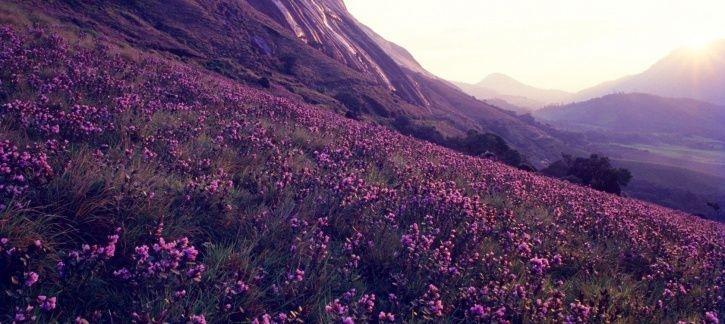The mystery surrounded by the blossom of the world famous Neelakurinji flowers is often puzzling. These rare flowers, located in vast terrains of the Nilgiris, blossom once in twelve years and turn the terrain into a blue carpet. They are eye catchy, striking, and surely are a sight to behold. These pretty flowers bloom only in the mountains of the Nilgiris, are found nowhere else, and are purplish blue in color.
Table of Contents
What are Neelakurinji Flowers?
Neelakurinji also was known as Strobilanthes Kunthiana falls under Plietesials category. They are shrubs which are found in the Western Ghats but are found only after decade long wait blooming period. Given that they bloom in Nilgiris, the term has been derived due to these flowers. Neela means blue, and giri means mountain, given the term Nilgiris. Hence this is what makes it a rare spectacle to watch in the kingdom of flora and fauna. After the long interval hence arrives these flowers.
The German scientist Christian Gottfried Daniel Nees von Esenbeck was the one who described these flowers back in the 19th century as belonging to Strobilanthes genus. People all across the world come to witness these mysterious flowers which add to the picturesque of Munnar.
Why are these flowers in Kerala?
Generally, these species are known to flourish in valleys only and are habituated to live in the colder climatic zone. They grow with an altitude of around 1400-2400 meters high after mid of the year between July to November time. Once they are bloomed after a period of 12 years, they are hence reproduced once in a lifetime and die after the flowering. The cycle again starts with seeds to sprouts. They generally are known to grow till 40-60 cm high. These flowers further tend to wither soon with the rainfall.
Neelakurinji grows across the shola grasslands in the Western Ghats and hence are found across Nilgiris of Karnataka, Kerala and Tamil Nadu. Mostly, tourists catch the beautiful eyesight in the Kerala region due to the proximity and ease to access. These blossoms of flora have been documented from the year 1838, and last blooming was just back in 2018 after mid.
Where else to witness these flowers?
Munnar is seen as the best site to experience these flowers. The tourists can sit and relax amidst the flowers and mountains. The view is totally eye candy and worth to live in a lifetime experience. Other parts of Western Ghats also provide a good view for these flowers like Kodaikanal and Ooty with bit different cycle. Hence these flowers add huge importance to these destinations at this time. The grand views and enchanting beauty is for sure going to live in our hearts forever.
Fauna related to Neelakurinji
Several zoologists and botanists have observed that there are a huge increase and rise of bee population during the blossoming of Neelakurinji. This interesting aspect has been observed with lots of stocks of honey amassed at this time. They flock to the vicinity for nectar.
What does Neelakurinji mean to communities around Nilgiris?
It is indeed an eye candy for us like tourists and travelers to experience the Neelakurinji flowers and the zone. However, the tribal communities around the Nilgiris and Munnar consider the flower as auspicious and with huge importance. It is believed that the Neelakurinji flowers were used by Lord Murugan while marrying Valli who is tribal hunger girl. Hence this flower is seen as a symbol of love and romance. This whole blossoming is considered as luck by them. The shrubs are taken due care of by these communities as per their beliefs from ancient times, and hence they make sure that seeds hit the time of maturity.
Neelakurinji and ecological conversation
Given the ancient situation, the contemporary era finds much lesser shrubs of Neelakurinji. During British time, the offices made the Ghats where these shrubs took their habitat to turn into plantations and sites of residence. However after independence time, the hills have been cleared, and development projects, mining, and plantations have come on their way here.
Hence, many activists and environmentalists vouch and propagate to save and conserve this Neelakurinji flowers to maintain ecological balance and rare flowers in the Ghats. Even campaigns were established around Munnar and Kodaikanal side to conserve these flowers. In this attempt to save these rare flowers, around 32 sq km area was turned as Kurinjimala sanctuary by Kerala’s Forest ministry in 2006.
The last bloom of Neelakurinji
The 12 th year of the blooming period was in 2018 around September. Munnar is a major site for this spectacle of blue hills has been prepared well to welcome tourists. The Eravikulam National Park had major blooming in the year and turned as a site to witness the flowers. Few treks were also organized by the forest department, and trekking was promoted to get amazing scenic hill views amidst the remote places for nature enthusiasts and trek lovers.
Other facts about these rare blossoms
Some of the other facts here include
- One can also notice different changes in color over the stages. It begins with blue color and turns purplish at the end of the stage.
- The flowers sometimes also begin to blossom from the bottom part of layers, and they reach top later point of time giving the rare spectacular views.
- The honey collected from Neelakurinji flowers has little bitterness which comes due to the flower. The honey hence is named and sold as Neelakurinji honey.
- Neelakurinji flowers and their blossoms have been also used as a method to track events and ages by the early tribal population in those surrounding areas.
Given the huge importance and rare sight with eye catchy scenic beauty, it is once in a lifetime experience to witness and live amidst these flowers for a while. Hence plan your trip wisely during the next bloom. Make sure to not miss this opportunity to experience and witness such beauty in grandeur.

